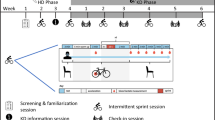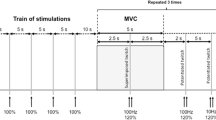Abstract
Carnosine is an abundant dipeptide in human skeletal muscle with proton buffering capacity. There is controversy as to whether training can increase muscle carnosine and thereby provide a mechanism for increased buffering capacity. This study investigated the effects of 5 weeks sprint training combined with a vegetarian or mixed diet on muscle carnosine, carnosine synthase mRNA expression and muscle buffering capacity. Twenty omnivorous subjects participated in a 5 week sprint training intervention (2–3 times per week). They were randomized into a vegetarian and mixed diet group. Measurements (before and after the intervention period) included carnosine content in soleus, gastrocnemius lateralis and tibialis anterior by proton magnetic resonance spectroscopy (1H-MRS), true-cut biopsy of the gastrocnemius lateralis to determine in vitro non-bicarbonate muscle buffering capacity, carnosine content (HPLC method) and carnosine synthase (CARNS) mRNA expression and 6 × 6 s repeated sprint ability (RSA) test. There was a significant diet × training interaction in soleus carnosine content, which was non-significantly increased (+11%) with mixed diet and non-significantly decreased (−9%) with vegetarian diet. Carnosine content in other muscles and gastrocnemius buffer capacity were not influenced by training. CARNS mRNA expression was independent of training, but decreased significantly in the vegetarian group. The performance during the RSA test improved by training, without difference between groups. We found a positive correlation (r = 0.517; p = 0.002) between an invasive and non-invasive method for muscle carnosine quantification. In conclusion, this study shows that 5 weeks sprint training has no effect on the muscle carnosine content and carnosine synthase mRNA.






Similar content being viewed by others
References
Abe H (2000) Role of histidine-related compounds as intracellular proton buffering constituents in vertebrate muscle. Biochemistry (Mosc) 65:757–765
Baguet A, Reyngoudt H, Pottier A, Everaert I, Callens S, Achten E, Derave W (2009) Carnosine loading and washout in human skeletal muscles. J Appl Physiol 106:837–842
Baguet A, Bourgois J, Vanhee L, Achten E, Derave W (2010a) Important role of muscle carnosine in rowing performance. J Appl Physiol 109:1096–1101
Baguet A, Koppo K, Pottier A, Derave W (2010b) Beta-Alanine supplementation reduces acidosis but not oxygen uptake response during high-intensity cycling exercise. Eur J Appl Physiol 108:495–503
Bakardjiev A, Bauer K (1994) Transport of beta-alanine and biosynthesis of carnosine by skeletal muscle cells in primary culture. Eur J Biochem 225:617–623
Bell GJ, Wenger HA (1988) The effect of one-legged sprint training on intramuscular pH and nonbicarbonate buffering capacity. Eur J Appl Physiol Occup Physiol 58:158–164
Bishop D, Edge J, Goodman C (2004) Muscle buffer capacity and aerobic fitness are associated with repeated-sprint ability in women. Eur J Appl Physiol 92:540–547
Bishop DJ, Edge J, Thomas C, Mercier J (2008) Effects of high-intensity training on muscle lactate transporters and post-exercise recovery of muscle lactate and hydrogen ions in women. Am J Physiol Regul Integr Comp Physiol 295(6):R1991–R1998
Bishop D, Edge J, Mendez-Villanueva A, Thomas C, Schneiker K (2009) High-intensity exercise decreases muscle buffer capacity via a decrease in protein buffering in human skeletal muscle. Pflugers Arch 458:929–936
Boldyrev A (2007) Carnosine and oxidative stress in cells and tissues. Nova Science Publishers, New York
Burke DG, Chilibeck PD, Parise G, Candow DG, Mahoney D, Tarnopolsky M (2003) Effect of creatine and weight training on muscle creatine and performance in vegetarians. Med Sci Sports Exerc 35:1946–1955
Derave W, Everaert I, Beeckman S, Baguet A (2010) Muscle carnosine metabolism and beta-alanine supplementation in relation to exercise and training. Sports Med 40:247–263
Derveaux S, Vandesompele J, Hellemans J (2010) How to do successful gene expression analysis using real-time PCR. Methods 50:227–230
Drozak J, Veiga-da-Cunha M, Vertommen D, Stroobant V, Van SE (2010) Molecular identification of carnosine synthase as ATP-grasp domain-containing protein 1 (ATPGD1). J Biol Chem 285:9346–9356
Dunnett M, Harris RC (1999) Influence of oral beta-alanine and l-histidine supplementation on the carnosine content of the gluteus medius. Equine Vet J Suppl 30:499–504
Edge J, Bishop D, Goodman C (2006a) The effects of training intensity on muscle buffer capacity in females. Eur J Appl Physiol 96:97–105
Edge J, Bishop D, Hill-Haas S, Dawson B, Goodman C (2006b) Comparison of muscle buffer capacity and repeated-sprint ability of untrained, endurance-trained and team-sport athletes. Eur J Appl Physiol 96:225–234
Edge J, Hill-Haas S, Goodman C, Bishop D (2006c) Effects of resistance training on H+ regulation, buffer capacity, and repeated sprints. Med Sci Sports Exerc 38:2004–2011
Everaert I, Mooyaart A, Baguet A, Zutinic A, Baelde H, Achten E, Taes Y, De Heer E, Derave W. 2010. Vegetarianism, female gender and increasing age, but not CNDP1 genotype, are associated with reduced muscle carnosine levels in humans. Amino Acids
Gibala MJ, Little JP, van EM, Wilkin GP, Burgomaster KA, Safdar A, Raha S, Tarnopolsky MA et al (2006) Short-term sprint interval versus traditional endurance training: similar initial adaptations in human skeletal muscle and exercise performance. J Physiol 575:901–911
Harmer AR, McKenna MJ, Sutton JR, Snow RJ, Ruell PA, Booth J, Thompson MW, Mackay NA, Stathis CG, Crameri RM, Carey MF, Eager DM (2000) Skeletal muscle metabolic and ionic adaptations during intense exercise following sprint training in humans. J Appl Physiol 89:1793–1803
Harris RC, Marlin DJ, Dunnett M, Snow DH, Hultman E (1990) Muscle buffering capacity and dipeptide content in the thoroughbred horse, greyhound dog and man. Comp Biochem Physiol A Comp Physiol 97:249–251
Harris RC, Jones G, Hill C, Kendrick IP, Boobis L, Kim CK, Kim HJ, Dang VH, Edge J, Wise JA (2007) The carnosine content in V Lateralis of vegetarians and omnivores (abstract). FASEB J 6:A944
Hill CA, Harris RC, Kim HJ, Harris BD, Sale C, Boobis LH, Kim CK, Wise JA (2007) Influence of beta-alanine supplementation on skeletal muscle carnosine concentrations and high-intensity cycling capacity. Amino Acids 32:225–233
Hirakoba K (1999) Buffering capacity in human skeletal muscle: a brief review. Bull Faculty Compt Sci Syst Eng Kyushu Inst Technol (Hum Sci) 12:1–21
Hultman E, Sahlin K (1980) Acid–base balance during exercise. Exerc Sport Sci Rev 8:41–128
Iaia FM, Thomassen M, Kolding H, Gunnarsson T, Wendell J, Rostgaard T, Nordsborg N, Krustrup P, Nybo L, Hellsten Y, Bangsbo J (2008) Reduced volume but increased training intensity elevates muscle Na+–K+ pump alpha1-subunit and NHE1 expression as well as short-term work capacity in humans. Am J Physiol Regul Integr Comp Physiol 294:R966–R974
Juel C (1998) Muscle pH regulation: role of training. Acta Physiol Scand 162:359–366
Juel C, Halestrap AP (1999) Lactate transport in skeletal muscle—role and regulation of the monocarboxylate transporter. J Physiol 517(Pt 3):633–642
Juel C, Klarskov C, Nielsen JJ, Krustrup P, Mohr M, Bangsbo J (2004) Effect of high-intensity intermittent training on lactate and H + release from human skeletal muscle. Am J Physiol Endocrinol Metab 286:E245–E251
Kendrick IP, Harris RC, Kim HJ, Kim CK, Dang VH, Lam TQ, Bui TT, Smith M, Wise JA (2008) The effects of 10 weeks of resistance training combined with beta-alanine supplementation on whole body strength, force production, muscular endurance and body composition. Amino Acids 34(4):547–554
Kendrick IP, Kim HJ, Harris RC, Kim CK, Dang VH, Lam TQ, Bui TT, Wise JA (2009) The effect of 4 weeks beta-alanine supplementation and isokinetic training on carnosine concentrations in type I and II human skeletal muscle fibres. Eur J Appl Physiol 106:131–138
Lukaszuk JM, Robertson RJ, Arch JE, Moore GE, Yaw KM, Kelley DE, Rubin JT, Moyna NM (2002) Effect of creatine supplementation and a lacto-ovo-vegetarian diet on muscle creatine concentration. Int J Sport Nutr Exerc Metab 12:336–348
Mannion AF, Jakeman PM, Dunnett M, Harris RC, Willan PL (1992) Carnosine and anserine concentrations in the quadriceps femoris muscle of healthy humans. Eur J Appl Physiol Occup Physiol 64:47–50
Mannion AF, Jakeman PM, Willan PL (1994) Effects of isokinetic training of the knee extensors on high-intensity exercise performance and skeletal muscle buffering. Eur J Appl Physiol Occup Physiol 68:356–361
McMahon S, Wenger HA (1998) The relationship between aerobic fitness and both power output and subsequent recovery during maximal intermittent exercise. J Sci Med Sport 1:219–227
Mohr M, Krustrup P, Nielsen JJ, Nybo L, Rasmussen MK, Juel C, Bangsbo J (2007) Effect of two different intense training regimens on skeletal muscle ion transport proteins and fatigue development. Am J Physiol Regul Integr Comp Physiol 292:R1594–R1602
Nevill ME, Boobis LH, Brooks S, Williams C (1989) Effect of training on muscle metabolism during treadmill sprinting. J Appl Physiol 67:2376–2382
Parkhouse WS, McKenzie DC (1984) Possible contribution of skeletal muscle buffers to enhanced anaerobic performance: a brief review. Med Sci Sports Exerc 16:328–338
Parkhouse WS, McKenzie DC, Hochachka PW, Ovalle WK (1985) Buffering capacity of deproteinized human vastus lateralis muscle. J Appl Physiol 58:14–17
Pilegaard H, Domino K, Noland T, Juel C, Hellsten Y, Halestrap AP, Bangsbo J (1999) Effect of high-intensity exercise training on lactate/H + transport capacity in human skeletal muscle. Am J Physiol 276:E255–E261
Ramadan S, Ratai EM, Wald LL, Mountford CE (2010) In vivo 1D and 2D correlation MR spectroscopy of the soleus muscle at 7T. J Magn Reson 204:91–98
Ross A, Leveritt M, Riek S (2001) Neural influences on sprint running: training adaptations and acute responses. Sports Med 31:409–425
Sahlin K, Henriksson J (1984) Buffer capacity and lactate accumulation in skeletal muscle of trained and untrained men. Acta Physiol Scand 122:331–339
Sanchez-Hernandez L, Marina ML, Crego AL (2011) A capillary electrophoresis-tandem mass spectrometry methodology for the determination of non-protein amino acids in vegetable oils as novel markers for the detection of adulterations in olive oils. J Chromatogr (in Press)
Sharp R, Costill D, Fink W, King D (1986) Effects of eight weeks of bicycle ergometer sprint training on human muscle buffering capacity. Int J Sports Med 7:13–17
Suzuki Y, Ito O, Takahashi H, Takamatsu K (2004) The effect of sprint training on skeletal muscle carnosine in humans. Int J Sport Health Sci 2:105–110
Thomas C, Bishop D, Moore-Morris T, Mercier J (2007) Effects of high-intensity training on MCT1, MCT4, and NBC expressions in rat skeletal muscles: influence of chronic metabolic alkalosis. Am J Physiol Endocrinol Metab 293:E916–E922
Troup JP, Metzger JM, Fitts RH (1986) Effect of high-intensity exercise training on functional capacity of limb skeletal muscle. J Appl Physiol 60:1743–1751
Venderley AM, Campbell WW (2006) Vegetarian diets : nutritional considerations for athletes. Sports Med 36:293–305
Weston AR, Myburgh KH, Lindsay FH, Dennis SC, Noakes TD, Hawley JA (1997) Skeletal muscle buffering capacity and endurance performance after high-intensity interval training by well-trained cyclists. Eur J Appl Physiol Occup Physiol 75:7–13
Acknowledgments
This study was financially supported by grants from the Research Foundation—Flanders (FWO 1.5.149.08 and G.0046.09) Audrey Baguet is a recipient of a PhD-scholarship from the Research Foundation—Flanders. The practical contribution of Jonathan Dehenau, Job Franssen and Bavo Verhasselt is greatly acknowledged.
The experiments of this manuscript comply with the current laws of Belgium.
Conflict of interest
The authors declare that they have no conflict of interest.
Author information
Authors and Affiliations
Corresponding author
Additional information
Communicated by Jacques R. Poortmans.
Rights and permissions
About this article
Cite this article
Baguet, A., Everaert, I., De Naeyer, H. et al. Effects of sprint training combined with vegetarian or mixed diet on muscle carnosine content and buffering capacity. Eur J Appl Physiol 111, 2571–2580 (2011). https://doi.org/10.1007/s00421-011-1877-4
Received:
Accepted:
Published:
Issue Date:
DOI: https://doi.org/10.1007/s00421-011-1877-4




